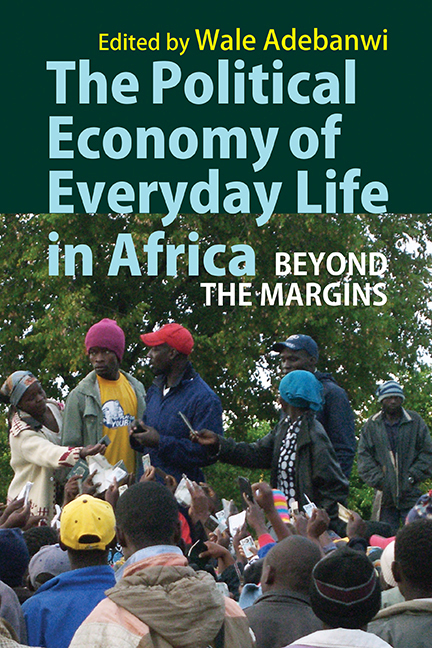Book contents
- Frontmatter
- Dedication
- Contents
- Maps, Illustrations & Tables
- Notes on Contributors
- Foreword
- Acknowledgements
- Approaching the Political Economy of Everyday Life An Introduction
- Part I MONEY MATTERS: CURRENCY & FISCAL LIFE STRUGGLES
- 1 Cattle, Currencies & the Politics of Commensuration on a Colonial Frontier
- 2 Currency & Conflict in Colonial Nigeria
- 3 Coercion or Trade? Multiple Self-realization during the Rubber Boom in German Kamerun (1899–1913)
- 4 The Macroeconomics of Marginal Gains Africa's Lessons to Social Theorists
- Part II LABOUR, SOCIAL LIVES & PRECARITY
- Part III MARGINALITY, DISAFFECTION & BIO-ECONOMIC DISTRESS
- Part IV HISTORICITY, TEMPORALITY, AGENCY & DEMOCRATIC LIFE
- Afterword: The Landscapes Beyond the Margins Agency, Optimization & the Power of the Empirical
- Index
2 - Currency & Conflict in Colonial Nigeria
from Part I - MONEY MATTERS: CURRENCY & FISCAL LIFE STRUGGLES
Published online by Cambridge University Press: 31 August 2018
- Frontmatter
- Dedication
- Contents
- Maps, Illustrations & Tables
- Notes on Contributors
- Foreword
- Acknowledgements
- Approaching the Political Economy of Everyday Life An Introduction
- Part I MONEY MATTERS: CURRENCY & FISCAL LIFE STRUGGLES
- 1 Cattle, Currencies & the Politics of Commensuration on a Colonial Frontier
- 2 Currency & Conflict in Colonial Nigeria
- 3 Coercion or Trade? Multiple Self-realization during the Rubber Boom in German Kamerun (1899–1913)
- 4 The Macroeconomics of Marginal Gains Africa's Lessons to Social Theorists
- Part II LABOUR, SOCIAL LIVES & PRECARITY
- Part III MARGINALITY, DISAFFECTION & BIO-ECONOMIC DISTRESS
- Part IV HISTORICITY, TEMPORALITY, AGENCY & DEMOCRATIC LIFE
- Afterword: The Landscapes Beyond the Margins Agency, Optimization & the Power of the Empirical
- Index
Summary
Money is mundane, but it is a mundane mystery to most who use it.
(Jane Guyer 1994: 26)This chapter examines a central theme in Jane Guyer's analysis of monetary transactions in Atlantic Africa – the implications of money valuation in relation to social order and disorder in Nigeria. It revisits the case of manilla currency exchange that she has discussed extensively in relation to calculation, ranking and political legitimacy (Guyer 2004, 2009). The manilla exchange rate is often ignored as a contributory factor in the various social upheavals of the region in the period before the manilla was ‘redeemed’ in 1948. Following Guyer's lead, and drawing on the pioneering scholarship of Naanen (1993), this chapter argues that manilla currency exchange critically exposed fault lines in gender relations and crucially amplified the social and economic tensions that contributed to two of the most significant conflicts in Nigeria during the colonial period – the Women's War (1929) and the ‘man-leopard murders’ (1943–8).
The ‘oil rivers’ region of south-eastern Nigeria had been a hub of Atlantic trade from the sixteenth century onwards. Located between two of the ‘oil rivers’ flowing south to the coast, the Annang territory discussed here lay adjacent to Ogoni and Igbo communities across the Imo River to the south and west, and to the Ibibio across the Qua Iboe River to the north-east. The economic basis of these neighbouring hinterland communities shifted during the nineteenth century from slaves to palm-oil exports. The effects of the fluctuations of the global palm-oil market were intensified in this region because of a peculiar economic feature, dual currencies of shilling and manilla. The manilla currency was originally introduced to the West African coast by the Portuguese as a bracelet. With the expansion of European trade from the late seventeenth century onwards, currencies became specialized between local uses and trading at the coast (Jones 1958; Latham 1971; Northrup 1978: 157–64). The brass rod, the currency used in Calabar, had been supplanted by British currency by the turn of the twentieth century. Elsewhere on the coast (between Oron and Ikot Ubo) copper wire currency was displaced by the shilling and the penny by 1920. Yet, elsewhere in Calabar Province, particularly in the Annang-speaking Ikot Ekpene, Abak and Opobo Divisions, the local manilla currency proved to be a durable medium of exchange until the late 1940s.
- Type
- Chapter
- Information
- The Political Economy of Everyday Life in AfricaBeyond the Margins, pp. 72 - 91Publisher: Boydell & BrewerPrint publication year: 2017



